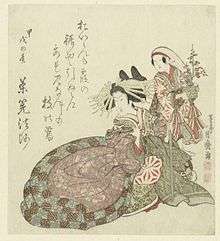Tsukimaro

Kitagawa Tsukimaro (喜多川 月麿, fl. c. 1794–1836 ) was a Japanese ukiyo-e artist. He was one of the most successful students of Kitagawa Utamaro (c. 1853 – 1806), from whom he took the -maro. His early works bear the name "Kikumaro", first written 菊麿 (kiku meaning "chrysanthemum") until 1802, then 喜久麿 (kiku meaning "joy eternal") until he changed it in 1804 to "Tsukimaro" (tsuki meaning "moon").[1]
Little is known of Tsukimaro's life.[1] His personal name was Jun (潤) and he had other nicknames (Japanese or Japanese).[2] He worked as a watchman in Kodenmachō Sanchōme in Edo (modern Tokyo), and at some point apprenticed under Utamaro. He specialized in bijin-ga portrait prints of female beauties. In 1804 he was one of the artists along with Utamaro who were arrested and manacled for making illegal prints of the 16th-century military leader Toyotomi Hideyoshi. Around 1820 he changed his name to Kansetsu (観雪) and turned to scroll paintings in the Maruyama–Maruyama–Shijō style. His last dated work is an illustration for a kyōka poetry anthology of 1836.[1] He also used the art names Sumitei (墨亭) and Shūsai (逎斎).[2]
References
- 1 2 3 Marks 2012, p. 112.
- 1 2 Fujikake 1946, p. 162.
Works cited
- Fujikake, Shizuya (1946). Zōtei Ukiyo-e 増訂浮世絵 [Ukiyo-e Revised Edition] (in Japanese). OCLC 36205779.
- Marks, Andreas (2012). Japanese Woodblock Prints: Artists, Publishers and Masterworks: 1680–1900. Tuttle Publishing. ISBN 978-1-4629-0599-7.
External links
 Media related to Tsukimaro at Wikimedia Commons
Media related to Tsukimaro at Wikimedia Commons